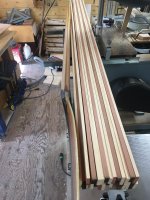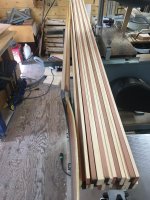Carbon fiber cloth is strongest in tension, less so in compression, and it abrades like a #2 pencil.
The load applied side of a simply supported beam (beam, truss, canoe hull, etc) is most often in compression, the far side in tension.
A canoe paddle is not a simply supported beam, rather it is a cantilevered beam...the load applied side is under tension.
So you should put the higher strength lay up on the tension side, and the lesser strength material on the back, or compression, side. All this assumes that the core has sufficient shear strength to survive the applied loads and resulting deflections.
Glenn forgot to include the units for the Young's modulus values above...in his examples it's GPa (Giga Pascals)...I can't think in Pascals, I'm a lbs/in^2 kinda guy.
Also, be careful about strength generalizations with respect to modulus, remember there is a dimensional aspect too, so 11 oz glass may be half the strength of 5.5 oz carbon rather than 1/4, due to the thickness disparity and the way the materials are sold and defined (weight/yd^2)
Regardless of the extreme high modulus of the carbon fiber, it's useless if the shear stresses exceed the shear strength of the epoxy holding it in place, or as mentioned above, if the core fails in shear.
Why then do canoe manufacturers put the carbon fiber on the outside of a hull???
Two reasons, first, it looks cool as hell, and cool sells boats.
Second, the designers don't design highly stressed components for a living! With the exception of high hertzian contact stresses (as from a very pointy rock), most loads that a canoe hull will see could be handled by an epoxy soaked T-shirt!! Of course there are other factors, but strictly from a strength point of view, even 4 oz E glass is sufficient.



